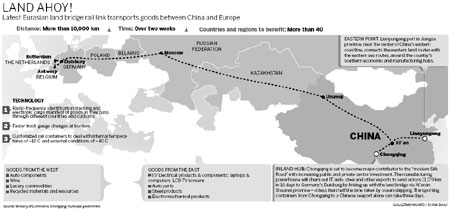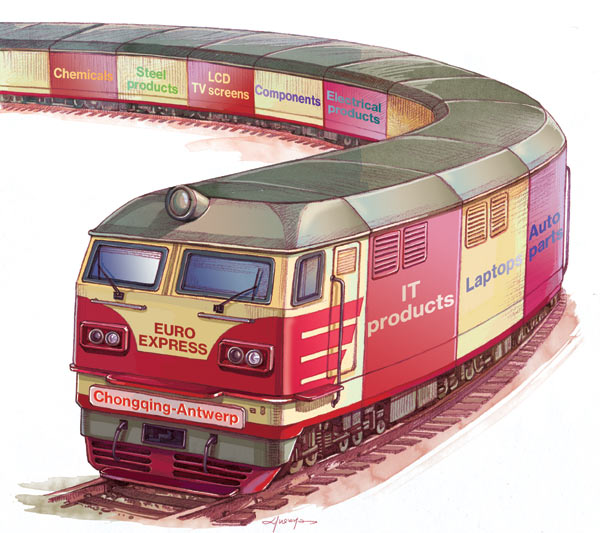
Legend has it that Chinese Emperor Wudi of the Han Dynasty (156-87 BC) once looked to the lands west of his vast empire and proclaimed them to have people who placed "great value on the rich produce of China".
|
 |
That regal observation soon spurred exploration of those foreign lands, leading to a network of trading routes between the East and West that came to be known as the Silk Road.
The historic route declined in the centuries that followed as maritime trade increased, but there are now renewed efforts to revive the continental link - this time through the latest addition to the Eurasian land bridge rail.
 |
Connecting Lianyungang port in East China's Jiangsu province to distant Belgium, the railway is being promoted as a shorter, more efficient way to transport goods between China and Europe. Lianyungang lies near the center of China's eastern coastline, where the country's southern economic and manufacturing hubs have helped enrich cities in provinces like Jiangsu and Zhejiang.
The land bridge traverses more than 10,000 km through China, Central Asia and Eastern Europe before arriving at European trading hubs like Rotterdam and Antwerp in about two weeks. The route is expected to benefit more than 40 countries and regions by taking less than half the time and enjoying a similar reduction in costs compared with transporting goods by sea.
Other routes under the Eurasian land bridge concept include an earlier one that consists of the Trans-Siberian Railway and the Russian seaport of Vladivostok. Yet another rail link considers connecting the southern Chinese city of Shenzhen with Rotterdam, through a 15,000-km route across 17 countries and regions - via Guangdong and Yunnan provinces as well as the Guangxi Zhuang autonomous region in China - before entering Myanmar, Bangladesh, India, Pakistan, Iran and Turkey toward its western destination.
Faced with higher production costs, maturing manufacturing industries and changing economic modes in eastern China's more economically developed coastal areas, Chinese authorities are now stepping up efforts to promote the benefits of the latest working route of the land bridge for Chinese goods to reach markets in the West as they look for ways to stay competitive.
Shen Dingli, professor of international studies at Shanghai-based Fudan University and executive dean of its Institute of International Studies, said the land bridge can help break the logistical barriers and bottlenecks in China's regional logistics flow as the country's western regions stand to benefit significantly from the new link.
To that effect, Chongqing, the southwestern municipality and an increasingly important manufacturing and trading hub of inland China, is already positioning itself as the latest crucial link of this Eurasian land bridge.
The megacity, one of the largest and fastest growing cities in the world with a 32-million-strong population, has opened a route to form part of the land bridge in the north at Shaanxi's provincial capital Xi'an - the historic city that flourished as the Chinese terminus of the Silk Road centuries ago.
The new link is expected to offer an attractive alternative for trading companies in Chongqing that need to operate through southern Chinese coastal ports such as Shanghai or Guangzhou before shipping their goods through the Strait of Malacca if they choose the maritime route, which can end up being more time consuming and costly.
Logistics companies such as DB Schenker and Far East Land Bridge are already using the land route to transport containers between Chongqing and European ports like Duisburg in Germany's Ruhr industrial belt.
The Chongqing-Europe link, which takes about two weeks, is banking on the megacity's goods coming from the IT, electronics, auto, steel, chemical and other sectors that are headed for European markets. Chongqing authorities said the railway will also seal the city as an international logistics hub by connecting the Yangtze River Delta economic belt to Europe.
Xu Ming, a senior official of Chongqing municipal committee, said the land bridge will be vital to China-Europe businesses.
"The old Silk Road connected the Eastern and Western empires. It was a great trading route of utmost importance and a vital artery in international commerce and the exchange of ideas between the East and West.
"This new route linking Chongqing to the West is the next big thing. It can shorten present shipping times by up to 20 days. It has received full support from various government ministries and departments to ensure the smooth flow and handling of goods. In terms of safety and security, it trumps the threats that maritime shipping might face, such as piracy," Xu said at this year's Liangjiang Forum in Chongqing to discuss the development of the land bridge as part of the challenges and opportunities in western China with business leaders and officials from both sides. Xu is also the director-general of the administrative committee of Chongqing's new Liangjiang development area.
"This 'New Silk Road' is better, faster and more efficient as it transports valuable goods between China and Europe. China-EU trade last year hit nearly $600 billion. Europe is China's biggest export market and we are Europe's second largest. In terms of luxury goods, China is set to become the largest market and that also has great significance for the European luxury goods market," he said.
"Chongqing is a major manufacturing hub and draws on the strengths of the Yangtze River Delta as an economic center. Its transportation links connect important cities and regions.
"As the next major trading link between China and Europe, the economic significance of its impact on helping the European debt crisis cannot be underestimated."







